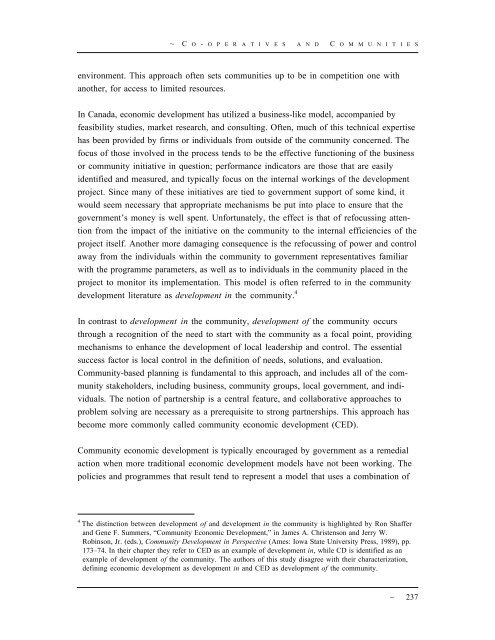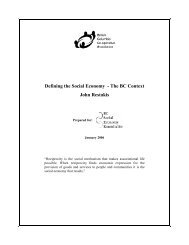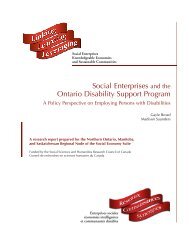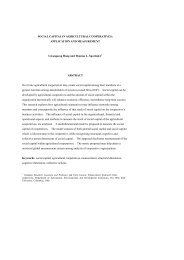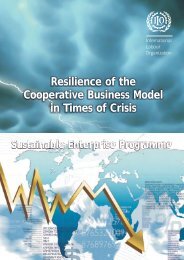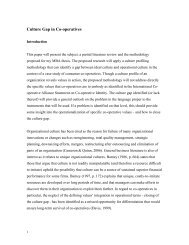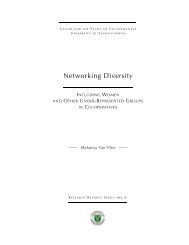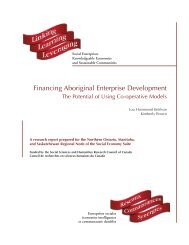Aboriginal Co-operatives in Canada - Centre for the Study of Co ...
Aboriginal Co-operatives in Canada - Centre for the Study of Co ...
Aboriginal Co-operatives in Canada - Centre for the Study of Co ...
Create successful ePaper yourself
Turn your PDF publications into a flip-book with our unique Google optimized e-Paper software.
~ C O - O P E R A T I V E S A N D C O M M U N I T I E Senvironment. This approach <strong>of</strong>ten sets communities up to be <strong>in</strong> competition one withano<strong>the</strong>r, <strong>for</strong> access to limited resources.In <strong>Canada</strong>, economic development has utilized a bus<strong>in</strong>ess-like model, accompanied byfeasibility studies, market research, and consult<strong>in</strong>g. Often, much <strong>of</strong> this technical expertisehas been provided by firms or <strong>in</strong>dividuals from outside <strong>of</strong> <strong>the</strong> community concerned. Thefocus <strong>of</strong> those <strong>in</strong>volved <strong>in</strong> <strong>the</strong> process tends to be <strong>the</strong> effective function<strong>in</strong>g <strong>of</strong> <strong>the</strong> bus<strong>in</strong>essor community <strong>in</strong>itiative <strong>in</strong> question; per<strong>for</strong>mance <strong>in</strong>dicators are those that are easilyidentified and measured, and typically focus on <strong>the</strong> <strong>in</strong>ternal work<strong>in</strong>gs <strong>of</strong> <strong>the</strong> developmentproject. S<strong>in</strong>ce many <strong>of</strong> <strong>the</strong>se <strong>in</strong>itiatives are tied to government support <strong>of</strong> some k<strong>in</strong>d, itwould seem necessary that appropriate mechanisms be put <strong>in</strong>to place to ensure that <strong>the</strong>government’s money is well spent. Un<strong>for</strong>tunately, <strong>the</strong> effect is that <strong>of</strong> refocuss<strong>in</strong>g attentionfrom <strong>the</strong> impact <strong>of</strong> <strong>the</strong> <strong>in</strong>itiative on <strong>the</strong> community to <strong>the</strong> <strong>in</strong>ternal efficiencies <strong>of</strong> <strong>the</strong>project itself. Ano<strong>the</strong>r more damag<strong>in</strong>g consequence is <strong>the</strong> refocuss<strong>in</strong>g <strong>of</strong> power and controlaway from <strong>the</strong> <strong>in</strong>dividuals with<strong>in</strong> <strong>the</strong> community to government representatives familiarwith <strong>the</strong> programme parameters, as well as to <strong>in</strong>dividuals <strong>in</strong> <strong>the</strong> community placed <strong>in</strong> <strong>the</strong>project to monitor its implementation. This model is <strong>of</strong>ten referred to <strong>in</strong> <strong>the</strong> communitydevelopment literature as development <strong>in</strong> <strong>the</strong> community. 4In contrast to development <strong>in</strong> <strong>the</strong> community, development <strong>of</strong> <strong>the</strong> community occursthrough a recognition <strong>of</strong> <strong>the</strong> need to start with <strong>the</strong> community as a focal po<strong>in</strong>t, provid<strong>in</strong>gmechanisms to enhance <strong>the</strong> development <strong>of</strong> local leadership and control. The essentialsuccess factor is local control <strong>in</strong> <strong>the</strong> def<strong>in</strong>ition <strong>of</strong> needs, solutions, and evaluation.<strong>Co</strong>mmunity-based plann<strong>in</strong>g is fundamental to this approach, and <strong>in</strong>cludes all <strong>of</strong> <strong>the</strong> communitystakeholders, <strong>in</strong>clud<strong>in</strong>g bus<strong>in</strong>ess, community groups, local government, and <strong>in</strong>dividuals.The notion <strong>of</strong> partnership is a central feature, and collaborative approaches toproblem solv<strong>in</strong>g are necessary as a prerequisite to strong partnerships. This approach hasbecome more commonly called community economic development (CED).<strong>Co</strong>mmunity economic development is typically encouraged by government as a remedialaction when more traditional economic development models have not been work<strong>in</strong>g. Thepolicies and programmes that result tend to represent a model that uses a comb<strong>in</strong>ation <strong>of</strong>4 The dist<strong>in</strong>ction between development <strong>of</strong> and development <strong>in</strong> <strong>the</strong> community is highlighted by Ron Shafferand Gene F. Summers, “<strong>Co</strong>mmunity Economic Development,” <strong>in</strong> James A. Christenson and Jerry W.Rob<strong>in</strong>son, Jr. (eds.), <strong>Co</strong>mmunity Development <strong>in</strong> Perspective (Ames: Iowa State University Press, 1989), pp.173–74. In <strong>the</strong>ir chapter <strong>the</strong>y refer to CED as an example <strong>of</strong> development <strong>in</strong>, while CD is identified as anexample <strong>of</strong> development <strong>of</strong> <strong>the</strong> community. The authors <strong>of</strong> this study disagree with <strong>the</strong>ir characterization,def<strong>in</strong><strong>in</strong>g economic development as development <strong>in</strong> and CED as development <strong>of</strong> <strong>the</strong> community.~ 237


